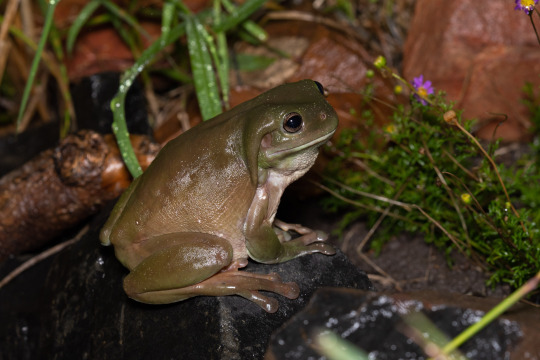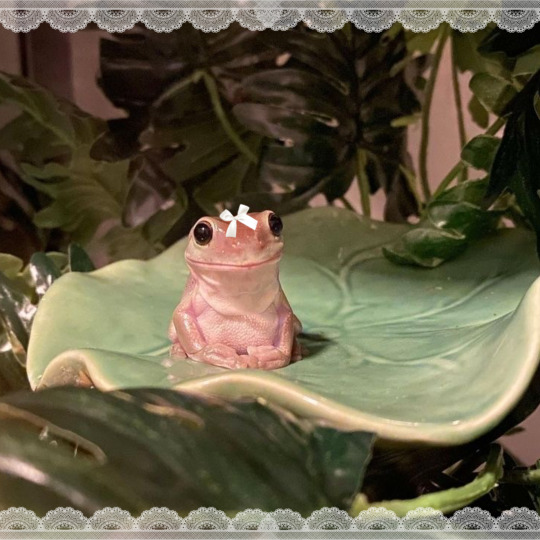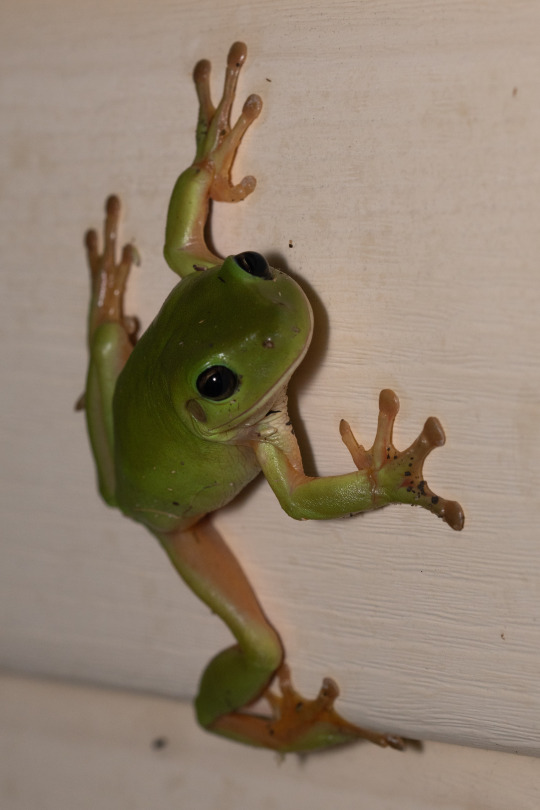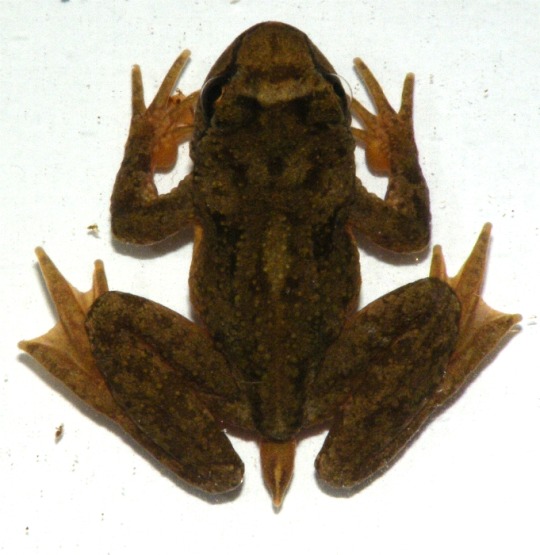#Litoria caerulea
Explore tagged Tumblr posts
Text

the largest Green Tree Frog I've ever seen, contemplating the daisies by the pond on a warm rainy night.

Green Tree Frog (Ranoidea/Litoria caerulea).
#ljsbugblog#bugblr#macro#not a bug#amphibia#amphibians#anura#frogs#herpetology#hylidae#tree frogs#ranoidea#ranoidea caerulea#litoria#litoria caerulea#green tree frog#australian green tree frog
831 notes
·
View notes
Text
Many Beautiful Frogs of Kuranda, Far North Queensland!
#frogs#animals#amphibians#Orange thighed tree frog#Litoria xanthomera#northern stony creek frog#Litoria jungguy#green eyed tree frog#Litoria serrata#green tree frogs#white’s tree frogs#Litoria caerulea#video#animal video#Kuranda
183 notes
·
View notes
Text

Green in green 💚
31 notes
·
View notes
Text

Australian Green Tree Frog
#australian green tree frog#green tree frog#tree frog#frog#Ranoidea caerulea#Litoria caerulea#Amphibia#Anura#Hylidae#Ranoidea#upl
9 notes
·
View notes
Text

this photo really captures everything important about me
#frog in a frog#and im wearing my frog shirt#i just really love frogs#green tree frog#whites tree frog#litoria caerulea#frog#herpetology#science#biology#amphibians#zoology#frogposting#women in science#this is Houdini#she went missing for 3 months and then just showed up outside
12 notes
·
View notes
Text

Australian Green Tree Frog (Ranoidea caerulea or Litoria caerulea), Metamorph/froglet, family Hylidae, found across northern Australia
Also called Dumpy Tree Frog or White’s Tree Frog.
photograph by FairyTail Dragons LLC
926 notes
·
View notes
Text

┌── ⋆⋅☆⋅⋆ ──┐
Topic of the day
└── ⋆⋅☆⋅⋆ ──┘
⁺˚⋆。°✩₊✩°。⋆˚⁺ Frogs ⁺˚⋆。°✩₊✩°。⋆˚⁺
What do you love about frogs?
I love a lot of things about frogs, I can name a lot of frogs; I feel like that’s my animal/thing I hyper-fixate on since my ADHD. Anytime a frog is brought up I go nuts in a good way. They just make me so happy, before I moved houses I used to get a lot of them in my backyard but now it’s just a desolate wasteland that only has grass and mud. My favorite is the Dumpy frog or known as the Australian green tree frog, or white’s tree frog orrrrr scientifically know as Ranoidea caerulea/Litoria caerulea. Look man, they are just so cute; and if you have multiple then it starts to become very obvious that there is only braincell in the tank at once and they all share it.
☆.。.:*・°☆.。.:*・°☆.。.:*・°☆.。.:*・°☆
Do you own any frogs?
Sadly no, I know it sucks but I know that I won’t be able to give it the best life it needs because I’m not home everyday, some days I’m barely there. Since I’m a swimmer I’ve got to be in the water 24/7 year round. I might get a couple once my life calms down a bit once I’m an adult but until then it’s just gonna be the five dogs that I have. I love my dogs but they are a handful.
☆.。.:*・°☆.。.:*・°☆.。.:*・°☆.。.:*・°☆
Where did your love of frogs begin?
Well, like most people it starts at an early age. I believe the first frog I ever saw and held was when I was 7; during elementary school P.E class. I guess I was labeled as the frog girl from then on out; which was fine with me because I was never really a social butterfly especially when it came to school. I would try to be but never got the hang of it; however that’s a different story time. Being a seven year old girl. And liking what other girls might classify as a slimy gross creature would kinda also help me be that non-social person. I remember when it had rained pretty good the night before and into the morning; and they had let us out for recess, which was really us playing on a field because the we were in a portable since the school was overflowing. Besides the point, but I saw a bunch of kids all huddled around something so I decided to join them. Lo and behold they were all picking and poking at this massive frog, he was probably the size of one of those fancy china plates that you never use. I looked at him more and felt that he was getting overwhelmed so i picked him up bare handed and took him over to a chain link fence and pushed his fat self through. Some of the kids were mad at me for doing that.. I don’t know why..
☆.。.:*・°☆.。.:*・°☆.。.:*・°☆.。.:*・°☆
Ciao!
#advice#frog art#cottage aesthetic#adhd problems#advertising#animals#green#cottagecore#coquette#sleep token#artists on tumblr#education#quotes#writing#this is what makes us girls#opinions#public news#swimmers#drama#frogs#gaming#blogging#news
2 notes
·
View notes
Text
youtube
Costa meets a gardener who has created a haven for frogs and gets his tips for pond design.
Sean is a garden landscaper and his own backyard is a 2.5-hectare block in the Noosa hinterland.
Here he has been able to explore his habitat hobby – building frog ponds. He has more than 50 here already and through his work reckons he has created about 600.
Sean has been creating habitat for wildlife since he was a young boy (he’d already built three by the time he was seven!) and he’s been learning about his current home environment and its flora and fauna for more than 20 years, transforming a barren horse paddock to a diverse paradise. He watches how the animals use the environment, then follows their lead to create better habitat for them.
He observed and followed the natural contours of the land to create water channels, adding mulch-like rocks and logs for extra habitat, and layers of plants, “because frogs exist in all the layers of vegetation, from trees to palms, grasses and groundcovers,” Sean explains. He has counted 17 different species of frog in his backyard.
Sean says that no matter what the type of pond or frog you want to cater for, in most climates you want the pond to receive a reasonable amount of sunlight but not too much. “Full sun will just lead to full on algae growth”
Cane toads don’t like moving through thick grass layers so he plants densely to try to keep these out.
To avoid breeding mosquitoes, Sean recommends installing a pump or waterfall to keep the water moving, but long-term he says you need patience to allow the natural ecosystem to build up, so predators will control their numbers.
Sean also grows lots of fruit and vegetables, keeping his family fed through the year, because he’s keen to show you can have both habitat and healthy food production.
Featured Frogs and Toads:
CANE TOAD - Rhinella marina
CASCADE TREE FROG - Litoria pearsoniana
GREEN TREE FROG - Litoria caerulea
EMERALD-SPOTTED TREE FROG - Litoria peronii
EASTERN SEDGEFROG - Litoria fallax
STRIPED MARSH FROG - Limnodynastes peronii
Featured Plants:
FLAX-LILY - Dianella sp.
CREEK MAT-RUSH - Lomandra hystrix
Filmed on Kabi Kabi Country | Pomona, Qld
#gardening australia#solarpunk#australia#frog#toad#frogs#toads#frogs and toads#habitat#frog habitat#gardening#garden#Youtube
5 notes
·
View notes
Text

©photography by Walter Jenkel 2023 Australian green tree frog (Litoria caerulea) NON-POISONOUS FROG WALTER JENKEL @WalterJenkel walter_jenkel
#australiangreentreefrog #litoriacaerulea #ranaarboricolaverdedeaustralia #walterjenkel
30 notes
·
View notes
Text
thought I would share some of the incredible amphibian diversity we see in our garden. all of these creatures are from the same genus of treefrogs, Litoria (excepting Green Tree frogs, which are also often described as genus Ranoidea).

a Broad-palmed Rocket Frog (Litoria latopalmata), who we have spotted in the bog cave the past few nights! this species has proven to be highly variable in colour and patterning, so always interesting to encounter.

the pebble-shaped Desert Tree Frog (Litoria rubella), who hunt insects on my car in multitudes.

one of my favourites, the Peron's Laughing Tree Frog (Litoria peronii). at a distance they appear a uniform beige, but a closer look reveals flecks of emerald green across textured skin. this species tends to be a bit larger than the other frogs, but is still dwarfed by the Green Tree Frog.

a Slender Bleating Tree Frog (Litoria balatus), who I have posted before. one of the smallest of the frogs we see, but nonetheless intriguing with their yellow toes, and vibrant red eye.

last, and largest, is the conspicuous Green Tree Frog (Litoria/Ranoidea caerulea), a species found across much of the continent, and frequently found around human dwellings.
that's 5 species of tree frog all found within our relatively small garden, which is pretty amazing. we've also recently encountered a pair of Striped Marsh Frogs (Lymnodynastes sp.) around the pond (hopefully I can get a good photo soon), and of course there are the ever-present Cane Toads (Rhinella marina).
#ljsbugblog#bugblr#not a bug#macro#amphibians#litoria#treefrogs#tree frogs#litoria latopalmata#broad-palmed rocket frog#litoria rubella#desert tree frog#litoria peronii#peron's laughing tree frog#litoria balatus#slender bleating tree frog#litoria caerulea#ranoidea caerulea#green tree frog#australian green tree frog
32 notes
·
View notes
Text




We also met these Green-eyed Tree Frogs with amazing jackets and a wild Green Tree Frog cousin of Jens and Voigt!
#frogs#animals#amphibians#green eyed tree frogs#Litoria serrata#white’s tree frogs#green tree frogs#Litoria caerulea#Kuranda
94 notes
·
View notes
Text

Experiment: 0022
Start of Experiment: 28/11/2009
Head Scientist of the Experiment: Doctor [REDACTED] from HR department (also known as Dr S
Genetic Making: 23% White Tree Frog (Litoria caerulea), 18% Firefly Squid (Watasenia scintillans), 31% [REDACTED], 16% Experiment 0001's DNA, 10% Venus flytrap (Dionaea muscipula), 2% Unknown
Biologic Characteristics:
Teeth are deep rooted similar to those found in Mammals and Crocodiles, the teeth are sharp in nature which in theory makes the experiment a carnivore (further test are to be conducted).
The subject have amphibian qualities, like frog-like skin that absorbs oxygen in water (also secrete mucous) and also a set of lungs with hidden nostrils on its face. Due to its amphibian nature, it's cold blooded, though tests and observations concluded that the subject body requires warm blood to function on its maximum capacity.
Six limbs with a similar muscle structure as a seen on a Squid adorned with sharp teeth-like bone on their ends, their function are to control the opening-and-closing of the mouth, and similar of the Venus Flytrap, most the mouth can open to 90⁰, its width reaching 0.6 m.
The blood flowing through its veins, apart from being copper-based, is biluminescent (only producing green like unlike its Squid counterpart), the biluminescence doesn't appear to be controlled by subject and the light is always present, the evolutionary purpose of it can not be concluded at the present.
Experiment has humanoid limbs with five toed feet, five fingered hands with opposable thumbs. Although, 0.8% longer than an average human, with height of 2,56 m. Theoretically bipedal, observed behavior on dry environments leads to believe the subject prefers crawling in all fours.
The experiment's brain looks human, though it is 0.5% larger than a human average. Further tests are to be conducted to test the subject intelligence and cognitive process, though from simple observations, the subject when younger (on its first five months) seemed to have the cognitive level of a human child.
Notes:
[NOTES REDACTED]
¡Upper level of access required!
Audio Transcript /05/2010 by Dr S (level 1 access)
Two-two's surgery was a success! It is still unconscious as I write this, but from the CCTV, we observed it is not shivering anymore! The tubes and hot pump need to be changed every few months but we all hope Two-Two'll be less aggressive towards the staff next time, so we won't need to restrain it during the changing process (it is not strong enough to break the restrains but it will persist until it break its bones)... I just hope it won't reject the "foreign object"( you can't see but I'm doing quotes with my hand heh) that is the pump and try to claw it out like Experiment 0031... The mess... [End of Audio]
#art#my art#monster#monster oc#oc lore#monster love#monster lover#artists on tumblr#monsterfucker#i did a lot of wiki surfing for animal facts#wow how i missed writing this kind of thing#:D#my most humanoid monster oc#drawing#drawing stuff
5 notes
·
View notes
Text


Tailed Frogs: Because the fast-flowing streams of Western North America where they are found prevent typical amphibian fertilization, this genus has developed a mechanism for internal fertilization. The “tail” of the frog is actually its cloaca, present only in males, and is controlled by a muscle unique to its genus. 45-75 eggs are laid under large rocks the spring after fertilization and tadpoles can take up to four years to metamorphosize. They lack tongues and do not vocalize. This genus is also one of the most primitive anurans still alive, with many skeletal similarities to fossils from the Jurassic period.
White's Tree Frog: This Australian frog is well-known for its prevalence in the pet trade. In the wild, it lives near water bodies or in eucalyptus trees, which often have hollows filled with water. It is actually a species complex, including the brown L. mira, found in New Guinea. Its parotoid gland secretes a waxy substance which it wipes across its body to increase moisture retention and absorption. However, this substance is also antiviral and antibacterial, and is being investigated for pharmaceutical use.
1 note
·
View note
Photo


横顔撮ろうと思ったら
こっちむいた😁
@あわしまマリンパーク
19 notes
·
View notes
Text
@litoria-caerulea lovey, please, stop. Putting bread in the fridge makes it stale 1000x faster than leaving it at room temperature. Freeze it if you must. You shouldn't have to deal with freezer burn at all if you wrap it well with plastic and parchment or foil. Also, warm it up in a toaster, air fryer, or oven, and it will restore the texture. Sincerely, a hobby bread baker.
It's stupid that bread goes bad so fast. Bread should last ten million years on your countertop. You should be able to feed yourself off the same loaf of bread from the day you are born to the day you die. They should pass down bread between generations like a family heirloom. There should be remnants of still-good bread after the heat death of the universe.
64K notes
·
View notes
Note
Hi ☺️ just want to say I’ve learned the names of many new herps and birds because of your page!! PS: my favorite bird is a Eurasian eagle owl, reptile is probably bushmaster snake, and amphibian is a dumpy tree frog
Thank you so much for following! Here are some friends for you...

Eurasian Eagle-Owl (Bubo bubo), family Strigidae, India
photograph by Khushboo and Rahul Sharma

South American Bushmaster (Lachesis muta), family Viperidae, Amazonian Bolivia
Venomous.
This is a large snake, that can grow up to 10 feet in length, but 8 ft long is more common.
photograph by Eduardo Navia

Australian Green Tree Frog (Ranoidea caerulea or Litoria caerulea), family Hylidae, found across northern Australia
Also called Dumpy Tree Frog or White's Tree Frog.
photograph by William Kreijkes
#tree frog#frog#litoria#australia#amphibian#eagle owl#owl#bird#india#bushmaster#snake#reptile#herpetology#animals#nature
122 notes
·
View notes